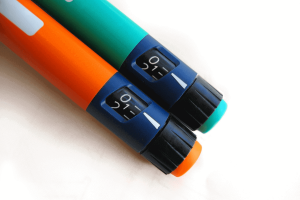Fatty Liver: One More Silent Killer
Fun Fact: Did you know your liver is larger than your brain?
First off, what is fatty liver disease?
Non-alcoholic fatty liver disease (NAFLD)–affects people that drink little to no alcohol. Fat is stored in and around the liver because the body has an excess of it. Non-alcoholic steatohepatitis (NASH) is a more severe form where the fat can cause scarring to the liver. The scarring can ultimately damage the liver from performing its necessary functions. The liver is an organ that can repair itself. Too much scarring of the liver can lead to a stage called cirrhosis where the liver cannot repair itself. At this stage, the organ has suffered irreparable damage.
About 25% of the general U.S. population has fatty liver, and most may not even know it. However, people with diabetes have a higher risk – over 50%.
What are the risk factors?
Risk factors include:
- High blood pressure
- Metabolic Syndrome (if at least 3 of 5 of the following)
- Waist Circumference (men >40 inches, women >35)
- Blood Pressure >130/85 mmHg
- Fasting triglycerides >150 mg/dL
- Fasting HDL Cholesterol (men <40 mg/dL, women <50)
- Fasting Blood Sugar >100 mg/dL
- Heart disease
- High Cholesterol
- Insulin Resistance
- Obesity
- Type 2 Diabetes
What are the symptoms?
- Abdominal swelling (fluid buildup)
- Yellowing of the skin (jaundice)
- Pain in the upper right side of the abdomen
If you are having any persistent symptoms, talk to a healthcare provider. They can diagnose NAFLD through liver tests, imaging with a fibroscan or MRI, or through a liver biopsy.
To prevent NAFLD the Mayo Clinic recommends:
- Diet – choose a plant-based diet that includes fruits, vegetables, and whole grains.
- Exercise – activity can reduce the risk of NAFLD. Maintain a consistent exercise plan that’s spread over multiple days of the week.
- Weight loss – if you are overweight or obese
Summary
Diet and exercise are important in order to reduce the risk of getting NAFLD. It does this by preventing abdominal fat from settling around the liver and causing damage to it. Long term, this can prevent liver scarring and dysfunction. Talk to your doctor about the fibroscan if you have any questions. Staying on top of your health is very important in preventing worse outcomes.
Disclaimer Statement: This is for educational purposes only and not intended as medical advice. For individual medical advice, contact your healthcare practitioner.





So would you need to have a fatty liver test if you have normal liver enzyme levels?
If you have several of the risk factors that are listed in the article, yes. And then especially if you are overweight. You may be in the early stages of fatty liver and liver enzymes may still be normal. A fibroscan may give you additional information to help evaluate your risk.